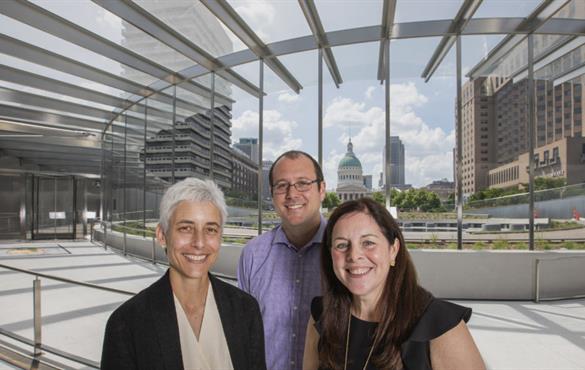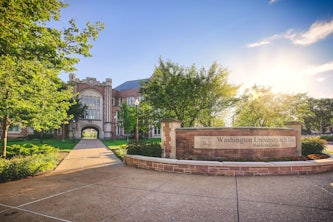Elevated attraction
Efforts of Washington University alumni proved pivotal in the transformation of the Gateway Arch grounds and museum. The only thing missing now, they say, is you!

St. Louisans love the Gateway Arch, but we rarely visit it. And why would we? The Gateway Arch is a tourist attraction, not necessarily a community draw.
Three Washington University in St. Louis alumni — Anna Leavey, MArch ’91, MCM ’11; Sarah Melinger, BA ’91; and Eric Moraczewski, EMBA ’16 — want to change that mindset.
The team works for the Gateway Arch Park Foundation, the nonprofit that joined forces with local, state and federal entities, private donors and civic organizations to revitalize the Gateway Arch and the public spaces that surround it. So far, the foundation has unveiled a new visitor center and museum, installed new biking and jogging paths along the Arch grounds and launched new events such as the free Blues at the Arch concert series and Arch Bark pet event. The foundation also has reimagined Kiener Plaza, adding a playground and splash pad, and made improvement to the riverfront. There are yoga classes and happy hours in the summer and ice skating in the winter.
Moraczewski’s favorite artifact is the Old Rock House, which was built in 1818 and was one of five riverfront buildings to survive the great fire of 1849. Its stones and doors, in storage since the building was dismantled in 1959, have been reassembled in the museum’s “Riverfront Era” gallery.
“You can learn so much about St. Louis from this one building, which was once a fur trading post and later became a speakeasy,” Moraczewski says. “It’s one of the many objects here that connect directly to this place. You could have moved the old museum to Colorado or anywhere on the Lewis & Clark Trail, but this experience really explains the role St. Louis — and these grounds specifically — played in our country.”
No less amazing than the new museum is the lushly landscaped bridge that seamlessly connects the Old Courthouse to the Gateway Arch. Before, visitors had to cross six lanes of traffic and a highway overpass to get to the Arch. The trek was so harrowing for some that the nearby Hyatt would hire taxis to safely ferry guests across the street. The new Luther Ely Smith Square offers shade trees, benches and the best view of the Arch.
“We’ve had to replace the sod three times since the square opened in 2015 because this is the spot to take pictures. It’s a great problem to have,” says Leavey, who walks the Arch grounds every Friday to observe how visitors are using the new public spaces. “The magnificence of the entrance now matches the grandeur of the Arch.”
Directly west of the Old Courthouse is a new Kiener Plaza, which hosts weekly exercise classes, happy hours, concerts and “Kiener Kids” playdates, as well as ice skating in the winter. Leavey says the foundation has installed extra tables and chairs to accommodate the swell of St. Louisans who take their lunch breaks at the plaza.
“People used to walk along the edges of Kiener Plaza; no one ever wanted to walk inside,” says Leavey, who served as director of construction for the project. “But now it’s a meeting place. People bring their children here to play. People will walk from City Garden to the Arch because there are places to rest and things to see. This project shows how landscape and smart urban planning changes people’s behaviors in a really positive way.”
The revitalized Arch is the largest public-private partnership in National Park Service history. Taxpayers approved a sales tax which raised $85 million in bond funds, and the Gateway Arch Park Foundation raised some $250 million in private donations, including a substantial gift from the family of the late Jack Taylor, the Enterprise Rent-A-Car founder and Washington University trustee emeritus. The balance was covered by city, state and federal funds. The project has created 1,000 construction jobs and is expected to draw 3.25 million more tourists to the Arch, about a million visitors more than its previous average attendance. Melinger hopes Washington University students are among them.
“St. Louis is their home now,” Melinger says. “And we want them to enjoy everything this city has to offer.”
Three Washington University in St. Louis alumni — Anna Leavey, MArch ’91, MCM ’11; Sarah Melinger, BA ’91; and Eric Moraczewski, EMBA ’16 — want to change that mindset.
The team works for the Gateway Arch Park Foundation, the nonprofit that joined forces with local, state and federal entities, private donors and civic organizations to revitalize the Gateway Arch and the public spaces that surround it. So far, the foundation has unveiled a new visitor center and museum, installed new biking and jogging paths along the Arch grounds and launched new events such as the free Blues at the Arch concert series and Arch Bark pet event. The foundation also has reimagined Kiener Plaza, adding a playground and splash pad, and made improvement to the riverfront. There are yoga classes and happy hours in the summer and ice skating in the winter.
“New Yorkers use Central Park. Chicagoans use Millennial Park. And St. Louisans should use this park,” says Melinger, director of development for the foundation. “You aren’t going to the top of the Arch every month, but you should come down for a free exercise class or concert series. We want people to check in and say, ‘What’s happening at the Arch this weekend.’”
On July 3, St. Louisans converged at the Arch for the debut of the renovated visitor center and underground museum. The entrance, a sleek, glass semicircle, now faces the Old Courthouse where slaves Dred and Harriet Scott sued for their freedom. No longer populated by taxidermied buffalo and animatronic settlers, the museum employs artifacts, video, photography and interactive displays to tell a richer, more complex story about Westward Expansion and St. Louis’ role in the evolution of the United States. Veteran National Park Service historian Bob Moore, MA ’96, PhD ’03, researched and developed the new exhibits.
On the projects’ competing goals: “Every partner, whether its was the city of St. Louis or the National Park Service had a list of ‘must haves.’ And then there were dozens of other players like the Coast Guard, the Department of Transportation and the Army Corp of Engineers, each with differing priorities. I really leaned on my WashU education to help me work with different groups and help everyone achieve their objectives.”
“The museum experience is both more accurate and more accessible,” says Moraczewski, who previously founded a growth strategy company before becoming executive director of the Gateway Arch Park Foundation. “The story is told for all abilities, so whether you are blind or low vision, deaf, in a wheelchair or have a different style of learning, you can have the same experience.”
On the projects’ competing goals: “Every partner, whether its was the city of St. Louis or the National Park Service had a list of ‘must haves.’ And then there were dozens of other players like the Coast Guard, the Department of Transportation and the Army Corp of Engineers, each with differing priorities. I really leaned on my WashU education to help me work with different groups and help everyone achieve their objectives.”
“The museum experience is both more accurate and more accessible,” says Moraczewski, who previously founded a growth strategy company before becoming executive director of the Gateway Arch Park Foundation. “The story is told for all abilities, so whether you are blind or low vision, deaf, in a wheelchair or have a different style of learning, you can have the same experience.”
Moraczewski’s favorite artifact is the Old Rock House, which was built in 1818 and was one of five riverfront buildings to survive the great fire of 1849. Its stones and doors, in storage since the building was dismantled in 1959, have been reassembled in the museum’s “Riverfront Era” gallery.
“You can learn so much about St. Louis from this one building, which was once a fur trading post and later became a speakeasy,” Moraczewski says. “It’s one of the many objects here that connect directly to this place. You could have moved the old museum to Colorado or anywhere on the Lewis & Clark Trail, but this experience really explains the role St. Louis — and these grounds specifically — played in our country.”
No less amazing than the new museum is the lushly landscaped bridge that seamlessly connects the Old Courthouse to the Gateway Arch. Before, visitors had to cross six lanes of traffic and a highway overpass to get to the Arch. The trek was so harrowing for some that the nearby Hyatt would hire taxis to safely ferry guests across the street. The new Luther Ely Smith Square offers shade trees, benches and the best view of the Arch.
“We’ve had to replace the sod three times since the square opened in 2015 because this is the spot to take pictures. It’s a great problem to have,” says Leavey, who walks the Arch grounds every Friday to observe how visitors are using the new public spaces. “The magnificence of the entrance now matches the grandeur of the Arch.”
Directly west of the Old Courthouse is a new Kiener Plaza, which hosts weekly exercise classes, happy hours, concerts and “Kiener Kids” playdates, as well as ice skating in the winter. Leavey says the foundation has installed extra tables and chairs to accommodate the swell of St. Louisans who take their lunch breaks at the plaza.
“People used to walk along the edges of Kiener Plaza; no one ever wanted to walk inside,” says Leavey, who served as director of construction for the project. “But now it’s a meeting place. People bring their children here to play. People will walk from City Garden to the Arch because there are places to rest and things to see. This project shows how landscape and smart urban planning changes people’s behaviors in a really positive way.”
The revitalized Arch is the largest public-private partnership in National Park Service history. Taxpayers approved a sales tax which raised $85 million in bond funds, and the Gateway Arch Park Foundation raised some $250 million in private donations, including a substantial gift from the family of the late Jack Taylor, the Enterprise Rent-A-Car founder and Washington University trustee emeritus. The balance was covered by city, state and federal funds. The project has created 1,000 construction jobs and is expected to draw 3.25 million more tourists to the Arch, about a million visitors more than its previous average attendance. Melinger hopes Washington University students are among them.
“St. Louis is their home now,” Melinger says. “And we want them to enjoy everything this city has to offer.”



